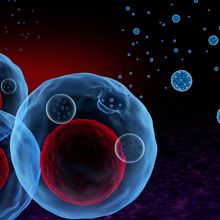cancer research

Crushing ChIP Like Never Before
Shelby Bradford, PhD | Jul 1, 2024 | 2 min read
A wayward lab chair ended three days of work in a single footfall for Elinne Becket.

Introduction to Oncolytic Virotherapy
Amielle Moreno, PhD | Jun 13, 2024 | 8 min read
Oncolytic virotherapy selectively attacks tumors and triggers both immediate and long-lasting immune responses.

Single Domain Antibodies: Small but Mighty Therapeutics
The Scientist | Mar 22, 2024 | 1 min read
Discover the benefits of VHH antibody-based therapies.

Turning Off Metastasis in Breast Cancer
Nathan Ni, PhD | Feb 13, 2024 | 4 min read
An on-off enzyme switch controls metastasis in mice.

The Vaginal Microbiome is Finally Getting Recognized
Hannah Thomasy, PhD, Drug Discovery News | Sep 25, 2023 | 10+ min read
Vaginal dysbiosis has long been a taboo subject, but studying and optimizing the vaginal microbiome could be a game changer for women's health.

How Tumors Tire Out T Cells
Bruker Cellular Analysis | Jul 19, 2023 | 1 min read
Researchers investigated how cancer antigenicity drives unique forms of T cell exhaustion and hypofunctionality.

Tasmanian Devils Face Threats from Rapidly Evolving Facial Cancers
Natalia Mesa, PhD | Jun 30, 2023 | 3 min read
A genetic study tracked the evolution of two transmissible cancers currently ravaging populations of Tasmanian devils.

CAR Technology in Cancer Therapy: From CAR-T to CAR-NK
The Scientist and Sino Biological | May 10, 2023 | 4 min read
From early target discovery to preclinical development stages, researchers explore novel strategies for effective cell therapies in cancer treatment.

Bacterial Tractor Beams Bring Radiation to Tumors
Rachael Moeller Gorman | Apr 17, 2023 | 3 min read
Colonizing tumors with engineered bacteria may allow researchers to target sites currently inaccessible to radionuclide therapy.

Cancer Cells Gather Speed in Thicker Fluids
Holly Barker, PhD | Nov 22, 2022 | 4 min read
Viscous solutions accelerate the migration of tumor cells and may enable metastasis, according to a new study.

Harboring Hard and Soft Cells Lets Tumors Grow and Metastasize Simultaneously
Katherine Irving | Oct 17, 2022 | 4 min read
Islands of rigid cells within a matrix of soft ones allow tumors to be both solid and fluid, granting them toughness without losing the ability to break apart.

Fred Hutch Receives $710 Million Gift from the Bezos Family
Shawna Williams | Oct 13, 2022 | 1 min read
The donation will fund recruitment, research facilities, clinical research, and immunotherapy research.

Broadening Tumor Molecular Profiling Horizons
Canopy Biosciences | Sep 21, 2022 | 1 min read
From histopathology to multiplex immunohistochemistry and spatial transcriptomics, learn how to obtain the appropriate profiling depth to match cancer classification needs.

Nanoparticles Spur Mouse Immune System to Attack Cancer
Shafaq Zia | Sep 13, 2022 | 2 min read
A study finds that engineered exosomes are effective in mice, but their potential use in humans raises safety questions.

Renee Wegrzyn Tapped to Head ARPA-H
Andy Carstens | Sep 12, 2022 | 2 min read
As the new agency’s director, the DARPA veteran will spearhead a high-risk, high-reward approach to biomedical research.

2D Genetic Map of Prostate Cells Charts Cancer Growth
Holly Barker, PhD | Aug 23, 2022 | 4 min read
An in situ map of copy number variations in prostate tissue reveals that purportedly cancerous genomic changes frequently occur in the healthy tissue surrounding tumors.

White House Names Monica Bertagnolli as NCI Director
Andy Carstens | Aug 10, 2022 | 2 min read
The announcement confirms earlier reports that Bertagnolli will become the first woman to lead the National Cancer Institute since its founding in 1937.

Glioblastoma Cells Imitate Immature Neurons to Invade the Brain
Sophie Fessl, PhD | Aug 5, 2022 | 3 min read
Neuron-like glioblastoma cells are the pioneers of deadly tumors’ spread through the brain, contributing to their devastating invasiveness, a study in mice finds.

Underdog Enzyme Likely Responsible for Mutations in Most Cancers
Sophie Fessl, PhD | Jul 28, 2022 | 3 min read
A previously overlooked enzyme called APOBEC3A is linked to the most prevalent mutational signatures in cancer cell lines, a study finds.
